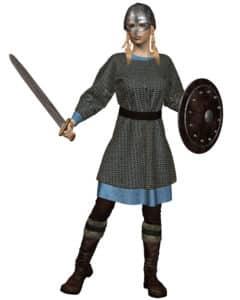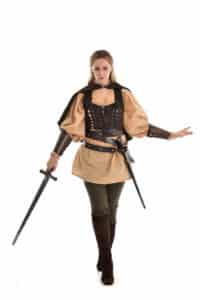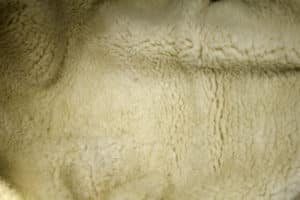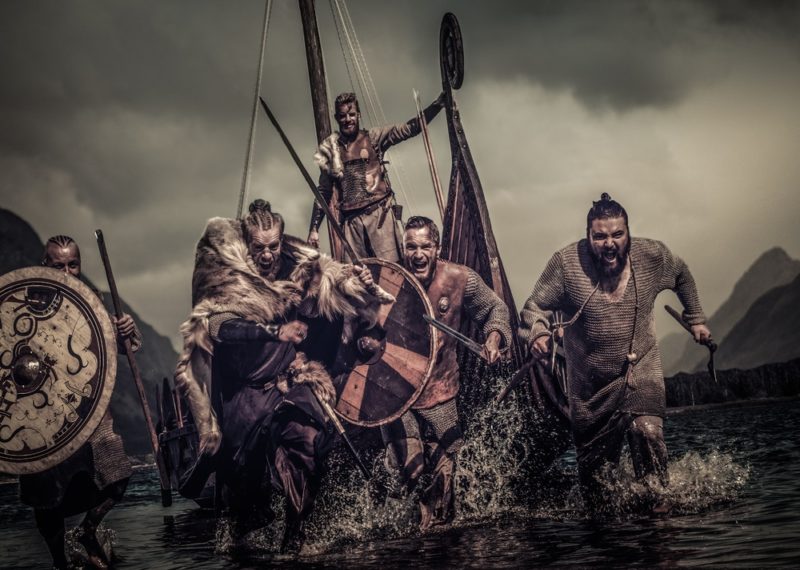Back in the day, the term Viking didn’t describe an ethnicity, but somewhat professions, the bellicose seafarer. However, this text will talk about the Scandinavian populations who adorned pieces of clothing known today as a Viking tunic during the beginning of the Middle Age.
It had to make the harsh Scandinavian climate more tolerable, hence why the Viking tunic was integral to everyday life. That was one of the reasons that the Vikings made their tunics from wools, as it was constantly available and helped with protections against the cold, the damp, and the wind. An under tunic was quite popular, and there was a variant made from linen that wealthier or hierarchical individuals wore.
The linen tunic serves the same purpose as the wool counterpart and helps to provide extra breathability. However, the upper tunic was adorned with colored fabric around the collar in some cases, and it was primarily made from wool.

Have Viking Tunics Been Found at Excavation Sites?
Most of the evidence about the qualities of the Viking tunics comes from sacrificial offerings and the excavation of gravesites. Unfortunately, they are not well preserved because natural fabrics are susceptible to decomposition.
However, significant excavations sites such as Haithabu extensively contribute to people’s understanding of Viking tunics. An example of this is some Vikings soaked their damaged clothes in tar using the attire to stop leaks on their ships.
Thanks to the tar, those specific clothing items have remained preserved, making it possible for scientists to learn more about the culture. Researchers have acquired a general understanding of what those tunics may have looked like a one time by reconstructing their findings.
What Is the History of Viking Tunics?

Surprisingly some have, even though very little material survives for 500 to 1000 years. We understand that Viking clothing comes from archeological sites, although it’s difficult to gauge all the information from the various sagas throughout history.
All Vikings wore the same basic cloth style: Men adorned, trousers and a thick shirt known as a tunic. Women wore an apron style dress over a single long dress that was ankle or floor length. Two brooches in the front fastened it, and the top hung over the shoulder from its apron straps.
Both women and men wore a linen tunic or undershirt underneath these woolen garments, which they may have slept in. Kids wore the same styles as their elders, but theirs had to be cut to significantly more petite sizes.
In order to keep out the wind and cold, Viking’s overgarments were made from durable, warm, and cozy wool. Scandinavians required warmth, and attire creation was such a timeous process that meant clothes had to last.
Viking farmers grew the flax from which the linen was made, and Viking sheep provided the wool for the clothes. Most Viking women spent a lot of their time making clothes for their families, weaving fabric, carding wool, or spinning thread.
Who Required a Linen Tunic?
Artisans, farmers, and warriors of the Viking cultures all require tunics that fit perfectly. A Viking’s over tunic or kyrtill was cut from an intricate pattern and then stitched together to form the entire garment.
These fitted garments allow the shoulders and arms to move around freely and easily. The tunic came down into a wide skirt that reached the knees or thighs. You can quickly fit a kyrtill over the head because of its keyhole neckline.
Most Viking men had cuffs at the end of their sleeves and a simple braid trim on the neckline. Women made the braid for the edge from beautifully colored yarns.
A Viking trouser may be worn loose or tight and was held up by a string passed through a loop or a belt. Typically made from wool, these pants could be left open or tucked into boots, plus they were also super warm. Durable goat skins were used to craft simple brown shoes for both sexes.

Women’s Sleeve Length Style
Falling to the floor or ankles, a woman overdress also had a keyhole neckline with long sleeve length. This means that a Viking’s wife wore an apron dress with panels of fabric in the back and front, held on the shoulder by the strap secured by two brooches. These clips were had a unique shape and were known as turtle brooches.
Most of these brooches were made from bronze, ivory, bone, silver, and even gold for the wealthier Viking females. A string of jet beads, amber, and colorful glassed adorned the apron dress, placed between the two brooches.
Vikings wore warm, long, thick wool cloaks over their clothes for warmth when traveling or moving around outdoors. Hats were made from fur, leather, or wool; leather belts pulled the outfit together, and woolen socks kept the feet under the boots or shoes. In order to have them close at hand, tools, pouches, and knives hung off the belt.
Men’s Viking Tunics
The Vikings wore their clothing in layers beginning with underwear made from linen. Most people had great quality clothes, but sometimes the poor would make their underpants from wool. The following layer was a knee-length tunic and trousers. There seem to have been two kinds of these, a more form-fitting bottom and top and a loose-fitting counterpart.
In most cases, a belt was worn around the waist from which a purse or knife was often suspended. These belts often hold other personal items such as charms, sentimental, or religious items. The tunic fell to mid-thigh and was bloused just above the belt.
Society in Scandinavian was divided into three categories:
- Thralls – enslaved people
- Karls – the lower class
- Jarls – aristocracy
The outfit we mentioned above would have been the essential daily attire of a Karl or Jarl. A Karl might wear a wool jacket over the outer shirt, and a Jarl would accessories their cloak borders with silk or lined it with fur. However, both classes would have some form of jewelry, necklaces, armbands, and headpieces to hold their hair. A woolen knee-length tunic held at the waist by a rope or belt was only worn by the Thralls.
Hide and soled were the two types of shoe options available to a Viking. The soled versions were made by sewing a rougher sole to a specific animal hide, while the hide shoes were stitched to themselves as one piece.
Most hides shoes were tied above the ankle with lacing and slipped on like a very thick sock. Boots were made from deerskin and cowhide and were usually soled shoes.
What Jewelry was Worn with Viking Tunics?
If you consider wearing a tunic as clothing for your next Halloween or dress-up event, you may want to consider what jewelry options go with it. Once you have made sure that your tunic fits correctly and the sleeves are rolled up at the hem, you can proceed to look for a precious stone to wear.
Please remember a cotton tunic is one of the most comfortable pieces you can get, and you can find one if you use the “search” function on our website. All our merchandise is made of amazing quality and comes with worldwide shipping. You will find a tunic for you in various colors, including blue, grey, white, brown, green, red, and much more. If you want more information, it is recommended to drop us an email to see how we can assist you.
Anyways, back to Norse jewelry! It’s good to note that a Viking would wear jewelry irrelevant to their sex. Below are some items that were favored by when a Viking wore a tunic:
- Brooches
- Beads
- Armbands
- Pendants
- Amulets
- Earings
- Armrings
- Toes rings
- Finger rings
- Bracelets
- Necklaces
- Neck rings
The Viking style of clothing was amazing, which is why many people want to wear a tunic when dressing up for events.
You Guys Are Going to Love the Viking Tunics We Have Available
Our site is decided to bring awesome quality Viking clothing that you will absolutely love. Whether you need Viking men or woman attire, we have a range of real-life and fun costumes that feels great plus come at the right price.
If you are worried about how a tunic will feel around your chest, it is recommended to consult the size guide of the product. You can also take your measurements and email us to find out if we have a costume or piece for you.
How Do You Find the Correct Viking Tunic?
Finding the suitable tunic for your body stature and color preference is the best way to be happy about your purchase. Before you abandon your cart, add something that perfectly matches your new tunic.
Anything from jewelry, boots, or a medium-sized jacket can be found here. You will find a range of products at the right price; all you need to do is search for them on the site. Be sure to measure your sizes before choosing an item from our shop and then decide what color you would like. You will be happy to know that the material used to create your new Viking tunic is of the highest quality, which is wonderful.
There is a vast amount of gear that you can use to bring your Viking costume to life, starting with a tunic. Many customers worldwide have enjoyed having an account with us because we make the sign-up process easy and natural.
If you are looking for a Viking tunic or any other piece of Viking attire at the right price and easy shipping, you have come to the right place. It is awesome to deal with a company that cares about the customer. What are you waiting for? Use the “search” bar to find the perfect Viking tunic for you!
Conclusion
With worldwide shipping, complete educational information, and outstanding customer satisfaction, you won’t find a tunic in a better place. The sleeves of these items will fit perfectly, and the material they are made from is of the best quality. No matter what color tunic you are interested in, whether it’s brown, green, blue, or grey, there is sure to be one to suit your taste and style.
This website is dedicated to everything Viking, so it’s an ideal place to find a Viking tunic for your next birthday bash or holiday extravaganzas.


